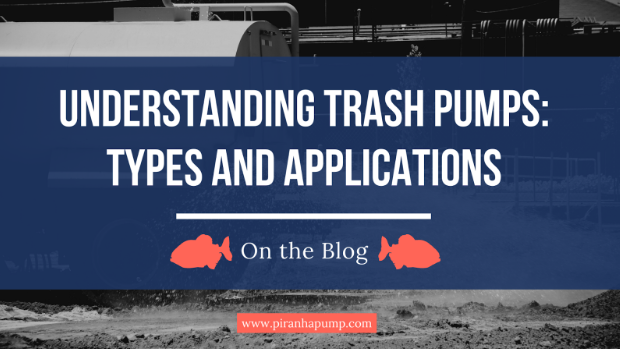When dewatering a worksite, it's best to work smarter, not harder. What better time to take advantage of trash pumps and all of their applications? Whether starting small with a wastewater trash pump or needing a sturdy solids handling pump, Piranha Pumps has the best heavy-duty submersible pumps in the business. Dive into our guide and find the perfect trash pump for you.
What is a Trash Pump?
A trash pump can conduct a substantial volume of debris-laden water, removing solids like leaves, sand, mud, and sludge from your worksite. These heavy-duty pumps are portable, making them ideal for flood control, agricultural clearing, mining, and industrial sites, and construction zones. The pump's mechanism depends on which type you buy—more on that below.
When Do You Need a Trash Pump?
Think of trash pumps as a water pump's stronger, bigger brother. Your worksite might have water that needs transporting, but once debris becomes part of the equation, you'll need a pump that won't get clogged by waste. Semi-trash pumps can handle small amounts of rubbish. They are routinely used to transport clean or moderately sandy/muddy water. Using a filter in the hose is common to ward off clogging.
Typical uses of semi-trash pumps are:
- Transferring oil and other fluids between tanks
- Emptying swimming pools
- Emergency uses such as removing water from flooded basements
Typical uses of industrial trash pumps are:
- Moving liquids in sewage bypass or repair applications
- Dewatering gravel pits
- Diverting streams or creeks
Different Kinds of Trash Pumps
Specific trash pumps will work better than others, depending on your work site conditions and project goals.
This pump utilizes recessed impellers to handle extra solids while minimizing abrasive wear. The pump has specialty coatings for corrosion resistance, which minimizes abrasive wear and increases the pump's lifetime. Our submersible pumps are fortified by stainless steel (not fabricated sheet metal, like less expensive pumps).
This pump utilizes kinetic energy to agitate the slurry into a state that's fluid enough for transportation. Without this energy, the pump would only transport water, leaving slurry to accumulate around the intake, eventually starving the pump. The mechanical agitator enables it to transfer stubborn elements such as settled mud, silt, slurry, and sand. Use this in industrial settings to pump heavier concentrations and larger quantities of sediment.
This pump can transfer moderate to heavy suspended solids such as sewage, debris, and slurry. This pump is popular for use in lagoon applications (animal & vegetable waste, wastewater) and trash applications (where solid buildup is too substantial for de-watering pumps). It can pass up to 3” size solids, making it a popular sewage pump.
This pump can transport water or water with light suspended solids. Corrosion-resistant coatings and float switch/control accessories are available for add-on. Especially useful for waterfront properties, flooded mines, and construction sites, these pumps provide strength, longevity, and efficiency.
Tips for Selecting a Pump
Looking closely at your surroundings and purpose will help you find the right pump.
Know Your Terrain
Understanding your site’s terrain will help you determine which pump to buy or rent.
A good rule of thumb is to ensure the hose diameter is twice the diameter of the solids you want to transport. For example, a 4" trash pump can handle up to 2" solids. A portable or semi-trash pump should get the job done if you're transporting smaller debris (sand, mud, etc.). You'll need a larger hose diameter if the terrain has larger solids such as stones, leaves, or twigs.
Also, the terrain can determine your pump material. For example, rubber hosing is sturdier against rocky terrain, and saltwater can wear down pumps without anti-corrosion features.
Be Familiar With the Specifications
Make sure that your worksite can support the hose's specifications. Some things to consider are:
- Maximum discharge flow
- Maximum discharge pressure
- Discharge size
- Power sources: Pumps can require alternating current (AC), direct current (DC), compressed air, diesel fuel, gasoline, natural gas, hydraulic systems, water, steam, and solar energy. If your pump comes without a power source, it typically comes with a drive shaft that connects to a motor.
Check For Maintenance Friendly Features
Choosing the right pump can help you prepare for the unexpected and minimize the time needed to resolve problems. Some things to look for are:
- Easy access to clog-vulnerable components
- A containment bund to prevent contamination of the site
- Self-priming and long-run time abilities (to keep operations low-risk in case you leave the pump unattended for an extended period)
About Piranha Pumps
Piranha Pumps started small, so we know the importance of paying attention to the little details. It's our goal that every customer who uses our equipment experiences a job well done. Now that you've seen how different trash pump applications can help you achieve your project to the highest standards, learn more about our other services:
At Piranha Pumps, we pride ourselves on giving the greatest service. Our competitive pricing and industrially advanced equipment are tailored to give you the best experience possible. Call us at (505) 822-0449 Or visit us at piranhapump.com to streamline your project today.
 PIRANHA
PIRANHA
